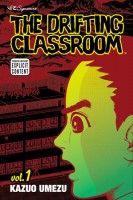My News and Reviews
Last week I declared it to be Usamaru Furuya Week here at Experiments in Manga. Ostensibly, it was to celebrate Furuya-sensei’s birthday, but mostly it was just an excuse for me to finally get around to reviewing more of his manga. I have now written an in-depth review of all of Furuya’s manga currently available in English. As for last week’s Furuya reviews, I have for your reading pleasure Short Cuts, Volume 2 (the final volume of one of my favorite gag manga), the second and third volumes of Genkaku Picasso (probably the most accessible entry into Furuya’s English manga), and the second and third volumes of No Longer Human (an excellent adaptation of Osamu Dazai’s novel No Longer Human). I’d love to see more of Furuya’s work translated. Although there are no immediate plans, I know that Vertical has expressed interest, so I am hopeful that someday we’ll see more.
Elsewhere online, manga translator and scholar Matt Thorn has an excellent piece Regarding Inio Asano’s gender identity. (He also talks a bit about his own gender identity.) And speaking of the complexities of gender, sexuality, and translation, a few months back I attended the lecture “Out Gays” or “Shameless Gays”? What Gets Lost, and What is Gained, when U.S. Queer Theory is Translated into Japanese? and posted some random musings about queer theory, Japanese literature, and translation. Well, the video of the lecture was posted earlier this month and is freely available to view. The most recent ANNCast, Vertical Vortex, features Ed Chavez from Vertical and included a license announcement for Takuma Morishige’s comedy manga My Neighbor Seki. In other licensing news, Seven Seas has acquired Kentarō Satō’s horror manga Magical Girl Apocalypse. Also, Seven Seas will soon be announcing licenses for a new yuri manga and a doujinshi (which is very unusual in English). Finally, Shawne Kleckner, the president of Right Stuf (one of my favorite places to find manga), recently participated in a Reddit Ask Me Anything.
Quick Takes
 The Drifting Classroom, Volumes 1-3 by Kazuo Umezu. An award-winning horror manga from the early 1970s, The Drifting Classroom is a series that I’ve been meaning to read. After a bizarre earthquake, Yamato Elementary School along with more than 860 students and staff disappear, leaving behind an enormous hole in the ground and very few clues as to what has happened. From the students’ perspective, everything outside the school has been turned into a wasteland. The situation they find themselves in may be extreme and unbelievable, but the consequences that follow are terrifyingly probable. The series’ setup allows Umezu to freely explore humanity’s darkness. The Drifting Classroom isn’t frightening because of the unknown; the true horror comes from how people react out of fear to the unexplainable. There are immediate concerns for survival, such as the lack of food and water, but even more problematic is the violence the erupts among the school’s survivors. The Drifting Classroom is an intense horror and survival manga with extremely dark psychological elements. I’ll definitely be reading more.
The Drifting Classroom, Volumes 1-3 by Kazuo Umezu. An award-winning horror manga from the early 1970s, The Drifting Classroom is a series that I’ve been meaning to read. After a bizarre earthquake, Yamato Elementary School along with more than 860 students and staff disappear, leaving behind an enormous hole in the ground and very few clues as to what has happened. From the students’ perspective, everything outside the school has been turned into a wasteland. The situation they find themselves in may be extreme and unbelievable, but the consequences that follow are terrifyingly probable. The series’ setup allows Umezu to freely explore humanity’s darkness. The Drifting Classroom isn’t frightening because of the unknown; the true horror comes from how people react out of fear to the unexplainable. There are immediate concerns for survival, such as the lack of food and water, but even more problematic is the violence the erupts among the school’s survivors. The Drifting Classroom is an intense horror and survival manga with extremely dark psychological elements. I’ll definitely be reading more.
 Missions of Love, Volume 6 by Ema Toyama. I started reading Missions of Love in the middle of the series. Although there is some background information that I am missing, I was still able to pick up on the major plot points fairly quickly. I really should go back and read the earlier volumes, though, as I’m enjoying the series much more than I anticipated. None of the characters are particularly nice people; their relationships are a twisted and tangled mess because of how they are all manipulating one another. And in the process, they’re confusing their own personal feelings as well. Missions of Love is intentionally scandalous and deliberately suggestive. However, it’s not exactly what I would call fanservice since it is meant more for the story and characters’ sakes rather than for the readers’. There are intimate moments and scenes of extreme vulnerability that challenge appropriateness but never quite cross the line, although Toyama frequently pushes the limits. I’m just waiting for something really terrible to happen. At this point, I can’t imagine that any of the characters in Missions of Love will be able to make it through the series unscathed.
Missions of Love, Volume 6 by Ema Toyama. I started reading Missions of Love in the middle of the series. Although there is some background information that I am missing, I was still able to pick up on the major plot points fairly quickly. I really should go back and read the earlier volumes, though, as I’m enjoying the series much more than I anticipated. None of the characters are particularly nice people; their relationships are a twisted and tangled mess because of how they are all manipulating one another. And in the process, they’re confusing their own personal feelings as well. Missions of Love is intentionally scandalous and deliberately suggestive. However, it’s not exactly what I would call fanservice since it is meant more for the story and characters’ sakes rather than for the readers’. There are intimate moments and scenes of extreme vulnerability that challenge appropriateness but never quite cross the line, although Toyama frequently pushes the limits. I’m just waiting for something really terrible to happen. At this point, I can’t imagine that any of the characters in Missions of Love will be able to make it through the series unscathed.
 Red Colored Elegy by Seiichi Hayashi. Another manga from the early 1970s, originally serialized in the alternative manga magazine Garo, Red Colored Elegy is only one of two volumes of Hayashi’s work available in English. The story follows Ichiro and Sachiko, two young animators in love and living together, but who are struggling to make ends meet as life slowly drives them apart. Hayashi’s artwork is deceptively simple and often free of backgrounds, placing the emphasis on the characters and their tumultuous lives and relationships. He conveys a tremendous amount of emotion through a minimalist, almost stream-of-conscious approach. Hayashi’s style in Red Colored Elegy can make it feel a bit disjointed from page to page, as though it were a collection of closely related vignettes rather than a single continuing story, but the overall melancholic mood created by the manga is consistent. Red Colored Elegy is about falling into and out of love and about pushing through life’s tragedies, both small and large. Emotionally compelling and beautifully crafted, Red Colored Elegy stands up to multiple readings.
Red Colored Elegy by Seiichi Hayashi. Another manga from the early 1970s, originally serialized in the alternative manga magazine Garo, Red Colored Elegy is only one of two volumes of Hayashi’s work available in English. The story follows Ichiro and Sachiko, two young animators in love and living together, but who are struggling to make ends meet as life slowly drives them apart. Hayashi’s artwork is deceptively simple and often free of backgrounds, placing the emphasis on the characters and their tumultuous lives and relationships. He conveys a tremendous amount of emotion through a minimalist, almost stream-of-conscious approach. Hayashi’s style in Red Colored Elegy can make it feel a bit disjointed from page to page, as though it were a collection of closely related vignettes rather than a single continuing story, but the overall melancholic mood created by the manga is consistent. Red Colored Elegy is about falling into and out of love and about pushing through life’s tragedies, both small and large. Emotionally compelling and beautifully crafted, Red Colored Elegy stands up to multiple readings.
 Yowamushi Pedal, Episodes 1-14 directed by Osamu Nabeshima. The Yowamushi Pedal anime series is based on an ongoing manga by Wataru Watanabe. Sakamichi Onoda is an otaku trying to revive the anime club at his new high school, but he quite unexpectedly finds himself caught up in the bicycle racing club instead. He has some natural talent at cycling—his frequent 90 km trips by bike to Akihabara probably didn’t hurt—but he has had no formal training. That’s about to change, though. The series so far has mostly focused on Onoda and the Sohoku High School racing club. The other teams that they will be facing have only been shown briefly. However, now that Onoda has started to get the basics of cycling down, the other cyclists are becoming more prominent in the story. I particularly like Yowamushi Pedal‘s casting; all of the characters have very distinctive speech patterns and voices which are very entertaining. I’m enjoying the series a great deal. Although I never was a racer and I don’t cycle as much as I used to (once upon a time, it was my primary mode of transportation), Yowamushi Pedal makes me want to get my bike out again.
Yowamushi Pedal, Episodes 1-14 directed by Osamu Nabeshima. The Yowamushi Pedal anime series is based on an ongoing manga by Wataru Watanabe. Sakamichi Onoda is an otaku trying to revive the anime club at his new high school, but he quite unexpectedly finds himself caught up in the bicycle racing club instead. He has some natural talent at cycling—his frequent 90 km trips by bike to Akihabara probably didn’t hurt—but he has had no formal training. That’s about to change, though. The series so far has mostly focused on Onoda and the Sohoku High School racing club. The other teams that they will be facing have only been shown briefly. However, now that Onoda has started to get the basics of cycling down, the other cyclists are becoming more prominent in the story. I particularly like Yowamushi Pedal‘s casting; all of the characters have very distinctive speech patterns and voices which are very entertaining. I’m enjoying the series a great deal. Although I never was a racer and I don’t cycle as much as I used to (once upon a time, it was my primary mode of transportation), Yowamushi Pedal makes me want to get my bike out again.
